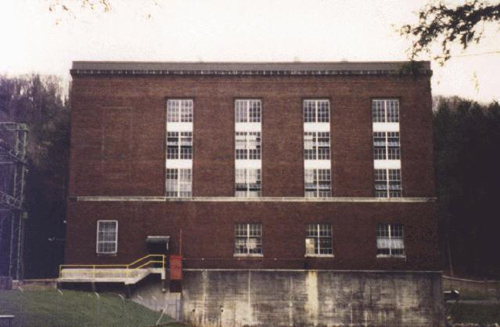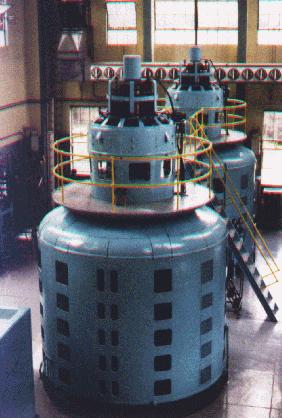 The Deep Creek Station
hydroelectric project was placed in service in 1925 by a predecessor company
of Pennsylvania Electric Company (Penelec). In 1968, the Federal Energy
Regulatory Commission (FERC) issued Penelec a license for the project
(FERC Project No. 2370). Since its construction, the lake has evolved
as the centerpiece of tourism in western Maryland. Discharges from the
project enter Maryland's only designated 'wild' river, the Youghiogheny,
which supports a reknowned trout fishery and one of the most challenging
kayaking and rafting runs in the country. In 1988, Penelec initiated renewal of Deep Creek Station's license
with FERC. As the coordinating agency for the state, the Power Plant Research
Program (PPRP) within the Maryland Department of Natural Resource was
involved at the outset of the relicensing and consulting process. PPRP
identified issues of concern and conducted necessary environmental studies
in close cooperation with Penelec. The relicensing process presented an
opportunity to develop and implement a plan for controlling the timing
and quantity of water released from the project to satisfy two objectives:
1) providing a reliable source of electricity, and 2) enhancing lake and
river natural and recreational resources. Because the interests of various
users of Deep Creek Lake's resources are often conflicting, this plan
required finding balanced solutions to a variety of technically complex
problems.
The Deep Creek Station
hydroelectric project was placed in service in 1925 by a predecessor company
of Pennsylvania Electric Company (Penelec). In 1968, the Federal Energy
Regulatory Commission (FERC) issued Penelec a license for the project
(FERC Project No. 2370). Since its construction, the lake has evolved
as the centerpiece of tourism in western Maryland. Discharges from the
project enter Maryland's only designated 'wild' river, the Youghiogheny,
which supports a reknowned trout fishery and one of the most challenging
kayaking and rafting runs in the country. In 1988, Penelec initiated renewal of Deep Creek Station's license
with FERC. As the coordinating agency for the state, the Power Plant Research
Program (PPRP) within the Maryland Department of Natural Resource was
involved at the outset of the relicensing and consulting process. PPRP
identified issues of concern and conducted necessary environmental studies
in close cooperation with Penelec. The relicensing process presented an
opportunity to develop and implement a plan for controlling the timing
and quantity of water released from the project to satisfy two objectives:
1) providing a reliable source of electricity, and 2) enhancing lake and
river natural and recreational resources. Because the interests of various
users of Deep Creek Lake's resources are often conflicting, this plan
required finding balanced solutions to a variety of technically complex
problems.
 In late 1991, the Deep Creek Project was released by Federal Energy Regulatory Commission
(FERC) from federal jurisdiction (effective in 1994) and is now operating
with a State of Maryland surface water appropriations permit administered
by the Department of the Environment. Power Plant Research Program has continued its involvement,
providing technical expertise to produce an equitable plan for water and
resource management at the project, currently owned by Brookfield
Renewable Energy Partners, L.P. The permit issued in 1994 and renewed
in 2011 includes conditions to balance the following suite of resource
and recreational concerns: 1) reservoir operations to make lake-based
recreational opportunities more dependable and extend further into autumn,
and to protect lake fisheries, 2) operation of the project to increase
the number and dependability of whitewater boating opportunities, 3) mitigation
of a long-standing DO problem in project discharges, 4) maintenance of
a continuous minimum flow in the river to increase trout habitat, and
5) timing of generation during summer to maintain coldwater habitat for
trout on a year-round basis.
In late 1991, the Deep Creek Project was released by Federal Energy Regulatory Commission
(FERC) from federal jurisdiction (effective in 1994) and is now operating
with a State of Maryland surface water appropriations permit administered
by the Department of the Environment. Power Plant Research Program has continued its involvement,
providing technical expertise to produce an equitable plan for water and
resource management at the project, currently owned by Brookfield
Renewable Energy Partners, L.P. The permit issued in 1994 and renewed
in 2011 includes conditions to balance the following suite of resource
and recreational concerns: 1) reservoir operations to make lake-based
recreational opportunities more dependable and extend further into autumn,
and to protect lake fisheries, 2) operation of the project to increase
the number and dependability of whitewater boating opportunities, 3) mitigation
of a long-standing DO problem in project discharges, 4) maintenance of
a continuous minimum flow in the river to increase trout habitat, and
5) timing of generation during summer to maintain coldwater habitat for
trout on a year-round basis.